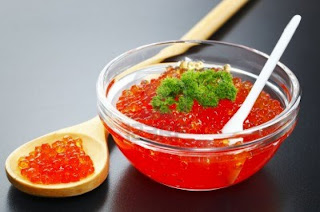Caviar - A Most Delightful Appetizer
A famous song from the 1940s went, "Oh Daddy! I want brand new car, champagne, caviar, Oh, Daddy!" Caviar was once served in the saloons of the Old West as an appetizer, though it was most typically served to royalty and members of high society.
In fact, the word Caviar comes from the Persian word Khaviar which means "bearing eggs". It comes from the sturgeon fish family, an endangered or threatened species which can weigh between 18 and 900 kilos, with 15-25% of its body weight being the eggs themselves. The fish eggs are called roe. They are harvested and salted, and become the world famous caviar.
Caviar may be shiny and in tiny pieces, much like pomegranate seeds. Other types of fish roe, like salmon roe, are used as ingredients in other dishes, like Japanese sushi. Caviar is filled with B-12, a known energy booster. It is also filled with cholesterol, nearly 100 mgs per Tablespoon.
Most caviar comes from the Caspian Sea area of Russia, as well as Iran (previously known as Persia) and several states of the former USSR - Azerbaijan, Kazakhstan, and Turkmenistan. However, this is not their exclusive habitat. These sturgeon fish may also be found in the shores outside of France, Belgium, and North America. As many as 50 varieties of sturgeon exist in the shores along the North American shorelines.
Caviar may be served on flavorless, non-porous mother of pearl spoons to prevent tainting of the delicate fish taste.
The most famous of all caviar types are the Beluga, Sevruga and Osetra varieties.
Beluga
The Beluga caviar has relatively large eggs. It has a rich, creamy flavor, delicate and rare. Ranging in color from light grey to a hematite-like black shade, it comes from the Husa husa, which can weigh from 36 to 900 kilos. The very large female Husa husa bears eggs from age 25 and may live up to 150 years.
The Beluga caviar has relatively large eggs. It has a rich, creamy flavor, delicate and rare. Ranging in color from light grey to a hematite-like black shade, it comes from the Husa husa, which can weigh from 36 to 900 kilos. The very large female Husa husa bears eggs from age 25 and may live up to 150 years.
Sevruga
The Sevruga has a stronger flavor and a grayish color. It comes from the smaller sturgeon, called the Acipenser Stellatus, which weighs only 22 kilos on average.
The Sevruga has a stronger flavor and a grayish color. It comes from the smaller sturgeon, called the Acipenser Stellatus, which weighs only 22 kilos on average.
Osetra
The Osetra may be golden or slightly brown in color, a bit nutty in flavor, and very prized. Called the Imperial caviar, it comes from the Acipenser Gulden, the medium sized fish, weighing in at 18-27 kilos.
The Osetra may be golden or slightly brown in color, a bit nutty in flavor, and very prized. Called the Imperial caviar, it comes from the Acipenser Gulden, the medium sized fish, weighing in at 18-27 kilos.
Caviar Production
Today, top caviar exportation is from Iran. Caspian Sea and Black Sea exportation has been stopped by the Environmental Protection Agency.
Generally speaking, overfishing has become a big threat to the sturgeon fish family. To this day, most varieties are threatened or endangered species. About 200 years ago, at the turn of the 19th century, Canadian and American fisheries dominated in caviar production. Concerns of overfishing caused the American variety to be placed under restrictive conditions. Today, a great deal of caviar is produced though fish farming techniques, or controlled harvesting. They are very high quality and are rated close to wild Caspian Sea caviar varieties.
To overcome the problem of overfishing and smuggling, many countries have begun organic and nonorganic sea farming techniques. Italy, Spain and Saudi Arabia now use sea farms to produce caviar.
Article Source: http://EzineArticles.com/7542363



Comments
Post a Comment